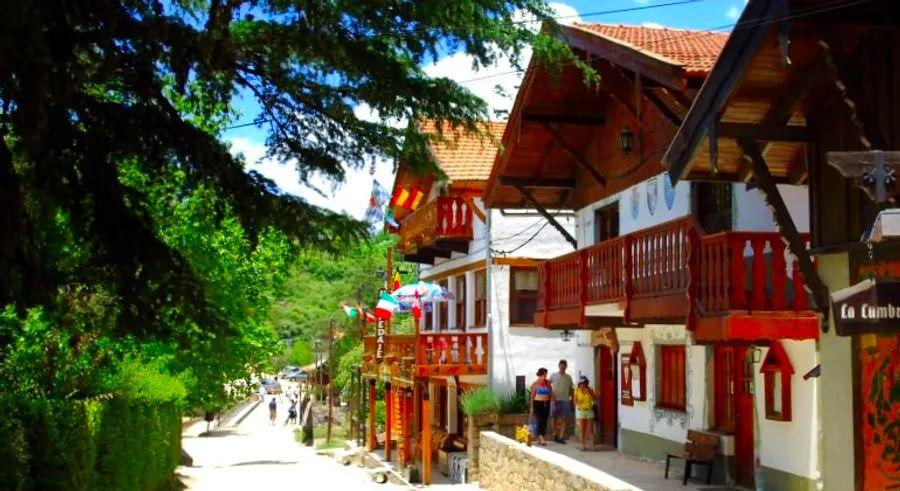La Cumbrecita: A German enclave nestled in Argentina

With its wooden cottages, hand-painted art, and vibrant flower boxes, La Cumbrecita feels like a picturesque German mountain village, even though it’s far from Bavaria.
German street signs, cafes serving traditional goulash, sausages, and schnitzel, and frosty steins of beer await visitors, all set against a backdrop of lush pine and spruce forests.
Though it seems like a scene straight out of a fairy tale, La Cumbrecita—home to just 1,500 residents—emerged from what was once barren Argentinian land. Today, it attracts over 300,000 visitors each year, drawn by its waterfalls, nature trails, and unique cultural charm.
GALLERY: Explore La Cumbrecita through photos
“The chapel, the fountain, the bridge at the town’s entrance—it all feels like it belongs in Central Europe,” says Mayor Daniel Lopez. His grandparents lived here when the town’s founder, seeking a place to build a summer retreat, first arrived. “We even have a traditional maypole.”
‘Stunned by the beauty’
Helmut Cabjolsky, the visionary behind the town, was a Berliner working as a civil engineer for Siemens when he was transferred to Buenos Aires in 1932. Disappointed by the city’s beaches, he longed for the mountains of his homeland.
A friend invited Helmut and his family to visit a remote farm near Córdoba, Argentina’s second-largest city. Their journey was long—first by train, then by car, and finally by horse, as no roads existed at the time.
“When they arrived, they were astounded by the beauty of the place—the rivers, the resources, the natural landscape,” says Ingrid Cabjolsky, Helmut’s granddaughter, who now runs a restaurant in one of the town’s original buildings, named in his honor.
“That caught their eye, and that’s when they decided to buy it.”

When Helmut purchased 500 hectares in 1934, the land was virtually devoid of vegetation—rocky terrain with a sparse covering of grass and few trees as far as the eye could see.
He brought over family members from Germany who were struggling to find work, organizing them to help construct the town’s first homes and establish a nursery.
They eventually transformed the sandy soil by planting thousands of trees, cultivating a unique forest of evergreens and oaks that is found only in this tiny corner of the Sierra Grande mountains, a place unlike anywhere else in Argentina.
Helmut began selling plots of land to close friends, many of whom were fellow immigrants from Central Europe he had met through his children’s German school in Buenos Aires. The only stipulation was that their homes must reflect the architecture of a Swiss, German, or Austrian village.
While continuing his work for Siemens, designing over 300 bridges across Argentina, Helmut’s family gradually improved the land—building roads, installing electricity, and enhancing infrastructure. Soon, a small village began to take shape at an altitude of around 5,000 feet above sea level.
‘I feel truly Argentine,’
Ingrid’s father spearheaded the efforts to develop La Cumbrecita into a popular tourist destination.
Though still a small town, La Cumbrecita boasts a log-cabin spa, around two dozen restaurants blending German and Argentine cuisine, and guided hikes to the picturesque waterfalls along the clear waters of the Almbach River.
While Spanish is the primary language heard in the shops, some families continue to speak German at home. The summer months are filled with festivals that celebrate the food, music, and traditions of the old country.
Ingrid’s restaurant—an alpine-style lodge with a low-sloping roof and stunning mountain views from the terrace—also serves as her home and a local museum. Its walls showcase vintage photos and framed documents that tell the story of the town’s growth.
The menu offers a mix of German staples like smoked fish, sauerkraut, and spaetzle, alongside dishes like seafood stir-fry and spaghetti bolognese, reflecting Argentina’s own diverse cultural influences.
“I feel very Argentine,” said Cabjolsky as birds chirped outside her window. “But it’s hard to explain because many of my customs, like the language, are German and are deeply ingrained in me. So, it’s a little bit of both.”

‘Looking ahead’
Beyond its unique cultural vibe, visitors are also drawn to La Cumbrecita for its peaceful atmosphere.
Hiking paths radiate from the town center, ziplines soar through the forest canopy for treetop adventures, and horseback riders journey along the forest’s edge, experiencing a totally different kind of mountain landscape.
The heart of La Cumbrecita remains tranquil. As Argentina’s only pedestrian-only village, the town has implemented several eco-friendly initiatives over the years to safeguard its environment. Nearly self-sufficient, La Cumbrecita relies entirely on renewable energy, recycles all of its water, and composts almost all its organic waste.
The result is a progressive town that feels centuries old. There are no chain stores, no gas stations, and no ATMs.
“The families who settled here had a clear vision for La Cumbrecita,” said Lopez.
“It’s a truly remarkable place. There’s nothing else like it.”

1

2

3

4

5
Evaluation :
5/5